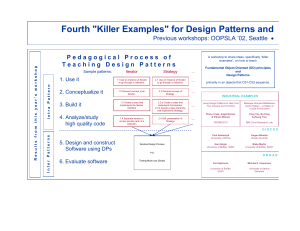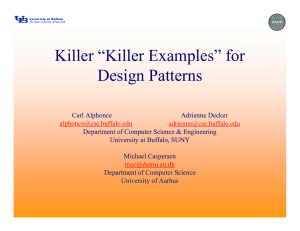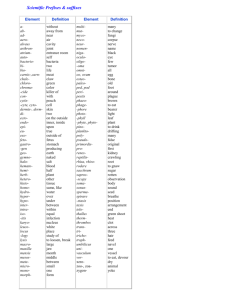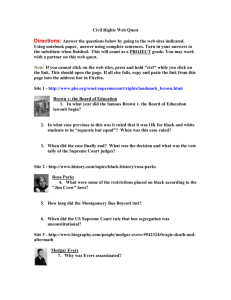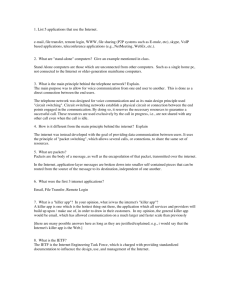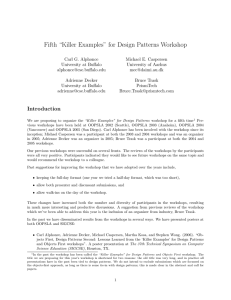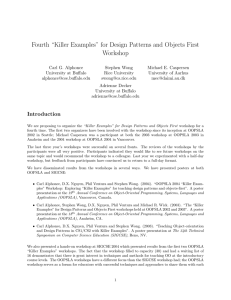"Killer Examples” for Design Patterns and Objects First Workshop s
advertisement
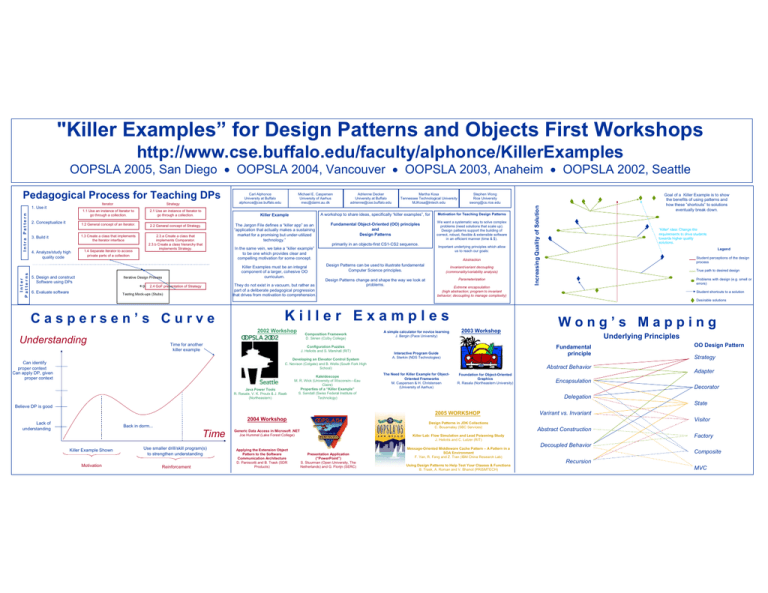
"Killer Examples” for Design Patterns and Objects First Workshops http://www.cse.buffalo.edu/faculty/alphonce/KillerExamples OOPSLA 2005, San Diego • OOPSLA 2004, Vancouver • OOPSLA 2003, Anaheim • OOPSLA 2002, Seattle Iterator Inter Patterns Intra Pattern 1. Use it Strategy 1.1 Use an instance of Iterator to go through a collection. 2.1 Use an instance of Iterator to go through a collection. 2. Conceptualize it 1.2 General concept of an Iterator. 2.2 General concept of Strategy. 3. Build it 1.3 Create a class that implements the Iterator interface 2.3.a Create a class that implements Comparator. 2.3.b Create a class hierarchy that implements Strategy. 4. Analyze/study high quality code 1.4 Separate Iterator to access private parts of a collection 5. Design and construct Software using DPs e.g. Michael E. Caspersen University of Aarhus mec@daimi.au.dk Testing Mock-ups (Stubs) Martha Kosa Tennessee Technological University MJKosa@tntech.edu Stephen Wong Rice University swong@cs.rice.edu Killer Example A workshop to share ideas, specifically “killer examples”, for Motivation for Teaching Design Patterns Fundamental Object-Oriented (OO) principles and Design Patterns We want a systematic way to solve complex problems (need solutions that scale up). Design patterns support the building of correct, robust, flexible & extensible software in an efficient manner (time & $). primarily in an objects-first CS1-CS2 sequence. In the same vein, we take a “killer example” to be one which provides clear and compelling motivation for some concept. They do not exist in a vacuum, but rather as part of a deliberate pedagogical progression that drives from motivation to comprehension. 2.4 GoF presentation of Strategy Adrienne Decker University at Buffalo adrienne@cse.buffalo.edu The Jargon File defines a “killer app” as an “application that actually makes a sustaining market for a promising but under-utilized technology.” Killer Examples must be an integral component of a larger, cohesive OO curriculum. Iterative Design Process 6. Evaluate software Carl Alphonce University at Buffalo alphonce@cse.buffalo.edu Important underlying principles which allow us to reach our goals: Abstraction Design Patterns can be used to illustrate fundamental Computer Science principles. Design Patterns change and shape the way we look at problems. Invariant/variant decoupling (commonality/variability analysis) Parameterization Goal of a Killer Example is to show the benefits of using patterns and how these ”shortcuts” to solutions eventually break down. Increasing Quality of Solution Pedagogical Process for Teaching DPs ”Killer” idea: Change the requirements to drive students towards higher quality solutions. Legend Student perceptions of the design process True path to desired design Problems with design (e.g. smell or errors) Extreme encapsulation (high abstraction; program to invariant behavior; decoupling to manage complexity) Student shortcuts to a solution Desirable solutions Caspersen’s Curve Killer Examples 2002 Workshop Understanding Time for another killer example Composition Framework D. Skrien (Colby College) Configuration Puzzles J. Heliotis and S. Marshall (RIT) Developing an Elevator Control System C. Nevison (Colgate) and B. Wells (South Fork High School) Can identify proper context Can apply DP, given proper context Java Power Tools R. Rasala, V. K. Proulx & J. Raab (Northeastern) Kaleidoscope M. R. Wick (University of Wisconsin—Eau Claire) Properties of a “Killer Example” S. Sendall (Swiss Federal Institute of Technology) A simple calculator for novice learning J. Bergin (Pace University) 2003 Workshop Wong’s Mapping Underlying Principles Fundamental principle Interactive Program Guide A. Sterkin (NDS Technologies) Abstract Behavior The Need for Killer Example for ObjectOriented Framworks M. Caspersen & H. Christensen (University of Aarhus) Foundation for Object-Oriented Graphics R. Rasala (Northeastern University) OO Design Pattern Strategy Adapter Encapsulation Decorator Delegation State Believe DP is good 2005 WORKSHOP 2004 Workshop Lack of understanding Design Patterns in JDK Collections C. Bouamalay (SBC Services) Back in dorm... Time Killer Example Shown Motivation Use smaller drill/skill program(s) to strengthen understanding Reinforcement Generic Data Access in Microsoft .NET Joe Hummel (Lake Forest College) Applying the Extension Object Pattern to the Software Communication Architecture D. Paniscotti and B. Trask (SDR Products) Varirant vs. Invariant Visitor Abstract Construction Factory Killer Lab: Flow Simulation and Lead Poisoning Study J. Heliotis and C. Lutzer (RIT) Presentation Application (“PowerPoint”) S. Stuurman (Open University, The Netherlands) and G. Florijn (SERC) Message-Oriented Middleware Cache Pattern – A Pattern in a SOA Environment F. Yan, R. Fang and Z. Tran (IBM China Research Lab) Using Design Patterns to Help Test Your Classes & Functions B. Trask, A. Roman and V. Bhanot (PRISMTECH) Decoupled Behavior Composite Recursion MVC
